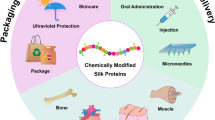Abstract
The effect of ethylene chlorohydrin on the treatment of silk with active dyes is studied by chromatography. The aminoacid glycine is used as a model for silk. Active dyes can be covalently bound to silk using ethylene chlorohydrin.
Similar content being viewed by others
References
I. Ya. Kalontarov,Properties and Applications of Active Dyes [in Russian], Dushanbe (1990).
M. Z. Abdukarimova, N. G. Valeeva, A. D. Midovanov, and K. E. Ergashev,Izv. Vyssh. Uchebn. Zaved., Khim. Khim. Tekhnol., No. 5, 118 (1993).
M. R. Abdullaeva, N. G. Valeeva, and M. Z. Abdukarimova,Shelk, No. 4, 22 (1991).
GOST 5618-80,Raw Silk.
Author information
Authors and Affiliations
Additional information
Translated from Khimiya Prirodnykh Soedinenii, No. 1, pp. 66–68, January–February, 2000.
Rights and permissions
About this article
Cite this article
Abdukarimova, M., Tashpulatov, Y.T. Modification of natural silk. Chem Nat Compd 36, 84–87 (2000). https://doi.org/10.1007/BF02234910
Received:
Issue Date:
DOI: https://doi.org/10.1007/BF02234910




